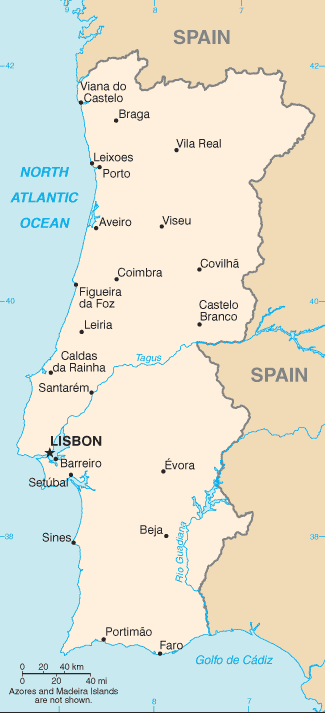|
Portugal
|

|
Capital: Lisbon
Population: 10,226,187
Brief History of Portugal:
Portugal is located on the west side of the Iberian Peninsula next to Spain which is on the east side of the Peninsula. The name Portugal comes from the Roman name for the town Portus Cale.
The area of Portugal was originally settled by the Celtic peoples. Later, the Phoenician empire and the Carthage Empire would visit the area. During the age of the Roman Empire, Portugal was a part of the Empire from 45 BC to 298 AD.
In 711 AD the Moors invaded and proceeded to conquer the Iberian Peninsula. They would hold on to some portion of the area for hundreds of years. The Christian nations began the Reconquista period where they would ?re-conquer? the Iberian Peninsula from the Islamic Moors. This effort took hundreds of years. It was in 1139 that the Kingdom of Portugal was formed. Afonso Henriques was the first King of Portugal.
Starting in the 14th century, Portugal became a major power in the Age of Exploration. Portuguese explorers such as Vasco da Gama and Ferdinand Magellan began to build Portugal into a vast colonial empire. Portugal established colonies in South America, Africa, and the Far East.
Portuguese power would dwindle in the 1900s. In 1932, Dr. Antonio Salazar took power as prime minister, but ruled more as a dictator. For 42 years, first Salazar and then Marcelo Caetano would rule Portugal. In 1974 a left wing military coup took over the country and made drastic democratic reforms including granting independence to all of Portugal's African colonies. Portugal was a founding member of NATO and is a member of the European Union.
The Geography of Portugal
Total Size: 92,391 square km
Size Comparison: slightly smaller than Indiana
Geographical Coordinates: 39 30 N, 8 00 W
World Region or Continent: Europe
General Terrain: mountainous north of the Tagus River, rolling plains in south
Geographical Low Point: Atlantic Ocean 0 m
Geographical High Point: Ponta do Pico (Pico or Pico Alto) on Ilha do Pico in the Azores 2,351 m
Climate: maritime temperate; cool and rainy in north, warmer and drier in south
Major cities: LISBON (capital) 2.808 million; Porto 1.344 million (2009), Vila Nova de Gaia
The People of Portugal
Type of Government: parliamentary democracy
Languages Spoken: Portuguese (official), Mirandese (official - but locally used)
Independence: 1143 (Kingdom of Portugal recognized); 5 October 1910 (independent republic proclaimed)
National Holiday: Portugal Day (Day of Portugal), 10 June (1580); note - also called Camoes Day, the day that revered national poet Luis de Camoes (1524-80) died
Nationality: Portuguese (singular and plural)
Religions: Roman Catholic 94%, Protestant (1995)
National Symbol: armillary sphere (a spherical astrolabe modeling objects in the sky)
National Anthem or Song: A Portugesa (The Song of the Portuguese)
Economy of Portugal
Major Industries: textiles and footwear; wood pulp, paper, and cork; metals and metalworking; oil refining; chemicals; fish canning; rubber and plastic products; ceramics; electronics and communications equipment; rail transportation equipment; aerospace equipment; ship construction and refurbishment; wine; tourism
Agricultural Products: grain, potatoes, tomatoes, olives, grapes; sheep, cattle, goats, swine, poultry, dairy products; fish
Natural Resources: fish, forests (cork), iron ore, copper, zinc, tin, tungsten, silver, gold, uranium, marble, clay, gypsum, salt, arable land, hydropower
Major Exports: clothing and footwear, machinery, chemicals, cork and paper products, hides
Major Imports: machinery and transport equipment, chemicals, petroleum, textiles, agricultural products
Currency: euro (EUR)
National GDP: $248,500,000,000
** Source for population (2012 est.) and GDP (2011 est.) is CIA World Factbook.
Back to Geography Home Page
